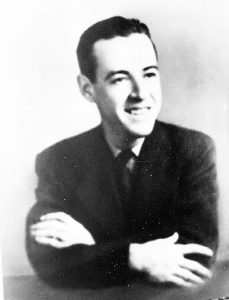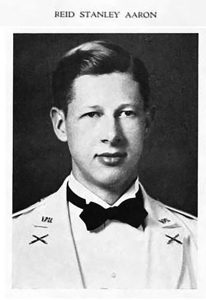This is the story of five young men with Patrick County ties who were imprisoned at Camp Cabanatuan, a Japanese-run prisoner of war camp in the Philippines; the horrors they endured; and the comfort of being with Virginians over 9,000 miles away from their beloved home.

Camden Ross Bryant (1916-1944) was born to Homer Orlando Bryant and Martha Magdaline Via Bryant. Camden’s paternal grandfather was Reverend Alexander Bryant, founder of Fairview and Rock Castle Church and pastor of Sycamore Baptist Church for many years, and grandmother, Sarah Jane Ross Bryant. Camden’s maternal grandparents were Peter Lee Via and Dicey Elizabeth King Via from the Dodson community of Patrick County.
2nd Lt. Reid “Stanley” Aaron (1918-1945) was born to John Reid Aaron and Jessie Stanley Aaron of Martinsville. Stanley was the nephew of Virginia Governor Thomas Bahnson Stanley, Sr. and Stanley’s brother, Jacob Crockett Aaron married Camden Bryant’s sister, Era Marie Bryant in 1948.
James Walter Trent (1919-1963) grew up in the area between Patrick Springs and Critz. James was the son of Walter Cole Trent and Nannie Virginia Witt Trent, the paternal grandson of Abe Trent and Nancy Spencer Trent, and the maternal grandson of Charles Richard Witt and Nancy Reynolds Witt of the Carter’s Store area of Henry County.
Ralph Jefferson Turner, Sr. (1922-1990) was born at Buffalo Ridge, Virginia to Abram Columbus Turner and Allie Walker Turner. Ralph was the paternal grandson of John Francis Turner and Nancy Adeline Nolen Turner and the maternal grandson of James Lincoln Walker and Mary Bowling Walker of the Elamsville district of Patrick County.
In 1940, Hayne Wesley Dominick, Jr. (1920-1995) was working as a car salesman at Burrough-White Chevrolet in Martinsville. In 1946, Hayne married Betty Ruth Critz, the daughter of William Russell Critz and Anna Ruth Tatum of Nettle Ridge. In November of 1945, Sgt. Hayne Dominick related his experiences in WWII to Kay Thompson who recorded them in chapter form. Thompson submitted them to the War Department, and they were released for publication. For the next few weeks, we will look at excerpts from Hayne’s account where he describes time spent with our Patrick (and Henry) County boys.

Chapter One, published on November 21st, 1945, Hayne recalled “I have two main reasons for telling you the facts. These were the best buddies a man ever had. In the Army, they talked about such fellows as describing them as ‘stock’ which means they were gentlemen: brave; unselfish; fine; patient; friendly; and enduring as any man who has fought under the Stars and Stripes. They were Stanley Aaron and Camden Bryant, two Martinsville heroes with whom I went to war and with and whom I shared a similar prison existence for more than two years.”
Hayne, “I also want to tell the story, too, in praise of Ralph Turner, of Stuart, who lived with us in the prison camp for more than two years in the Philippines and was later sent to a camp in Japan, where he was severely burned just before his liberation. I want no credit or sympathy for what I went through, but people should know what these boys gave to their country. They should know the undying hope that they had for another day in the land where they were born. I was the lucky one, Stanley and Camden were not. Both died when the Japanese moved them out of the Philippines. I had already gone ahead to Japan because Camden Bryant persuaded me to go. And the same I feel towards Stanley Aaron, the only officer among us. He used to share his extra pay with Camden and me in the hope that we might be able to supplement our daily rice rations with purchases from the Filipino people.”
Chapter Two, published on November 22, 1945, Hayne remembered, “On Friday, June 21, 1941, Camden R. Bryant, son of Homer O. Bryant, of Ranson Road, of Martinsville was given his discharge as a selective service private at Camp Lee for reenlistment in the Air Corps. He was assigned to the 47th Bombardment Squadron at Hamilton Field, Fresno, California. He was 25 at the time. In due time, I ran across Camden and though I had not known him well in Martinsville, we became fast friends. In the same month of the same year, Reid Stanley Aaron, son of Mr. and Mrs. John R. Aaron of 300 Starling Avenue, Martinsville was commissioned a second lieutenant and made his way presently to California. Camden and I ran into him at Fort McDowell, to which he had been transferred on October 28th, for overseas shipment. Stanley and I were old friends and we talked for hours there at McDowell about home and the dates we used to have there together. He was 22 years old when he got inducted. At noon, November 1st, 1941, Stanley, Camden and I sailed from San Francisco to the Philippines aboard the USS President Coolidge on its’ second run as a government-operated transport. Camden and I were in the same outfit-the 34th Pursuit Squadron. Stanley was an administrative officer with the 48th Material Squadron. On arriving at Manila, we were separated. Stanley was assigned to Fort McKinley and Camden and I were sent to Nichols Field overlooking Manila Bay. On the night of December 7th, 1941, Camden and I went to the neighboring town, and we each ordered a whole fried chicken. Little did I know, this would be Camden’s last fried chicken and my last one for four years.”
Chapter Three, published on November 23, 1945, Hayne recounted, “On the morning of December 10th, 1941, Japanese planes first arrived on the fields we occupied at Del Carmen. Camden and I slept by our guns-on the ground. I was at Gun Position Number 1 and Camden was nearby at another position. Only three of the 28 planes at our field had been equipped with oxygen tanks, so the pilots had no chance of flying higher than 10,000 feet or they would black out from lack of oxygen. The Japanese were flying at a much higher altitude and were having a field day. The retreat order came on that bleak Christmas Day 1941. It was a blow to our morale….On January 4, 1942, after General MacArthur had evacuated Manila, our five remaining planes were ordered to report to another squadron and Camden and I’s group to Little Baguio, 40 miles deeper in Bataan’s jungles. Our outfit was ordered to take up the defense of Agaloma Bay and Camden and I were put on machine guns. We slept by our guns, in torrid heat, pestered by mosquitos and other insects. There was no shelter from the rain. During those days and nights, Camden and I hardly slept. We stayed glued to our machine guns. After March 10th, the Japanese made no further attempts to land at Agaloma Beach and that was the last actual engagement that Camden and I had on the battlefield against the enemy. We were supposed to go to the front lines on April 10th but on April 9th, General Jonathan Wainwright surrendered all forces on Bataan, saying that the action was taken to spare the lives of American boys under his command.”
For the next few weeks, we will look at excerpts from Hayne’s account of his time spent as a POW with his friends from Patrick and Henry County. Thank you so much to Joshua Martin, Darlene Thielman, and Richard Presnell for their help with this story. Woody may be reached at rockcastlecreek1@gmail.com or (276) 692-9626.




